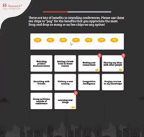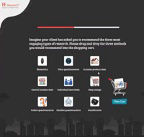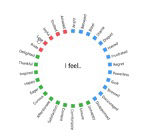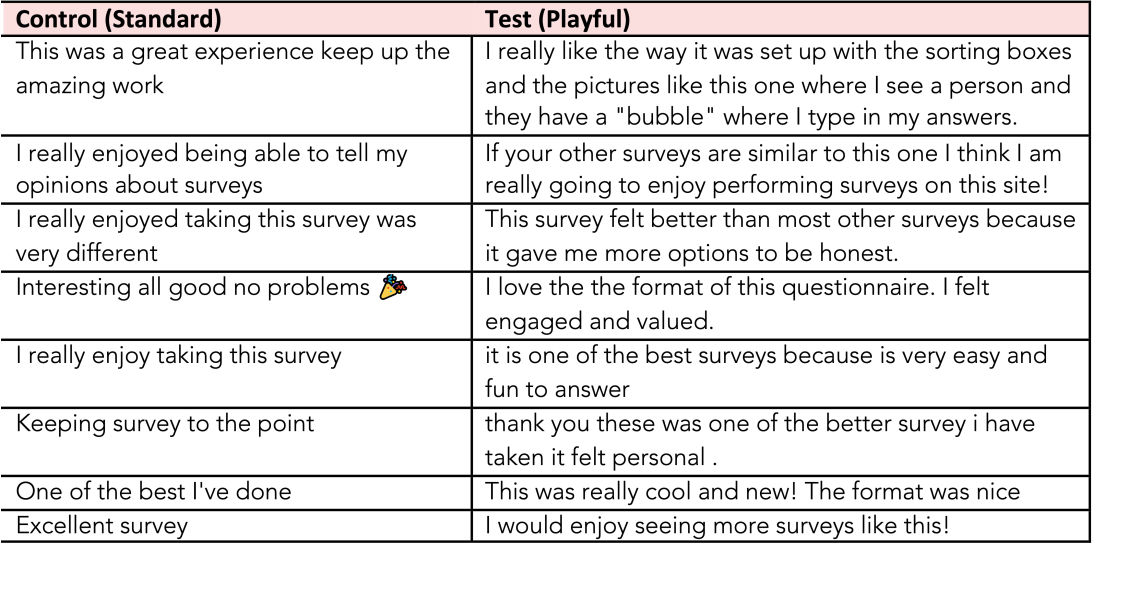Let’s bring play back to research
Research used to be playful.

When online questionnaires first burst onto the scene, they were innovative, fun, and exciting. People hadn’t seen anything like them before so they had fun clicking in circles and boxes, and writing comments in textboxes.
Oh, times have changed. Survey links are now plastered on every store receipt, flyer, and email. And whether we’re riding the local transit system or laying on the couch at home, we can play any of a thousand fun games on our cell phones.
With so many ways for people to have a bit of fun, survey researchers struggle with low response rates and participant engagement. There are many contributing factors, but one very rectifiable cause is common to all – surveys can be boring. Researchers need practical solutions to convert boring surveys back into the playful exercises they once were and, hopefully, improve the survey experience.
Fortunately, designing engaging data collection tools isn’t an all or nothing game. Online questionnaires don’t have to be fully gamified OR boring. We can incorporate more creative questions and fun activities that stimulate the mind, evoke creativity, and add a little spice to the questionnaire process.
Participants are seeking engagement
Naturally, we’ve fielded surveys to ask people how they feel about participating in research. In a recent Test/Control experiment to better understand how people view different types of surveys, we asked the exact same set of questions in two different ways. The Standard questionnaire used click-based radio-button, check-box, and text box questions while the Playful questionnaire incorporated color, imagery, and animated drag and drop motions, and encouraging words. The animated gifs you see here are just three examples of what more playful questions could look like.



In both versions of the questionnaire, we asked people to rank ten reasons for answering questionnaires. Among people who got the Standard questions, the #1 ranked reason was to earn the incentives – 36%. And, 11% said they completed surveys because they were “fun.” On the other hand, among people in the Playful group, only 25% selected incentives as their #1 reason while 32% said their #1 ranked reason was “for fun.” Simply answering a more playful and engaging survey was sufficient to remind people that the survey experience can be fun!
At the end of the questionnaire, we also invited people to share their thoughts about the survey they just completed. As you see in the example verbatims shown here, participants in the Playful group were more likely to indicate that the experience was fun and that they enjoyed how the questions were presented to them. As a bonus, their comments were also more detailed.
People like and want more engaging questionnaires!

Researchers know questionnaires need to be improved
Researchers know what questionnaire participants want. But do researchers know how to make it happen? Before and during Esomar congress, we invited the research community to share their opinions. (You’re welcome to share yours as well.) When asked to choose the three most engaging types of research from a limited selection of ten options, person-to-person methods topped the list. Focus groups (61%), interviews (53%), and shop-alongs (46%) easily landed in first, second, and third place as the most engaging methods.
Surprisingly, online questionnaires were not in the bottom three! Chatbot questionnaires (6%), voice questionnaires (12%), and central location tests (12%) claimed that undesirable position. Unfortunately, that’s still not much of a win since only 22% of participants indicated that online questionnaires are the most engaging method.
There is an experience interaction, though. Only 14% of researchers who’ve written 200+ questionnaires think questionnaire are engaging whereas 36% of researchers who’ve written fewer than 100 questionnaires think questionnaires are engaging. Perhaps it’s a sign that more experienced researchers need to rethink their templates and try something new.
Despite the fact we know questionnaires aren’t the most engaging data collection tool, many of us aren’t including playful options in our questionnaires. Almost half of researchers who answered our survey said fewer than 25% of their questionnaires incorporate playfulness. This number increases to nearly 70% for people who’ve been in the industry 30 to 44 years. And overall, only about 12% of people said they include playfulness in nearly every questionnaire they work on. There is much room to do better.
Researchers know how to improve questionnaires
Despite perceptions that questionnaires are boring, researchers have a good understanding of what to do and what not do when it comes to making them more engaging and playful. Our survey of researchers revealed a set of common advantages, disadvantages, and recommendations for playful surveys.
Advantages
Increased attention: Playful questionnaires are more engaging, hold the attention of participants longer, and can lead to higher completion rates.
Increased thoughtfulness: People take more care to think about their answers fully and creatively.
Increased quality: Data is higher quality because the questions and answers are more tangible and meaningful.
Increased respect: Playful questionnaires help people see that researchers are humans too.
Disadvantages
Distracting: Playful questions that don’t specifically related to the survey topic can be distracting, complicated, and introduce bias.
Childish: Some people may view the research as childish and not take their participation seriously, particularly for B2B topics.
Audience specific: Not all people appreciate or enjoy playful questions.
Costly: It’s a lot of work, time, and money to design and program playful questions that work on every device.
Recommendations
Justify: Don’t disregard the basic tenets of questionnaire design just to incorporate playfulness. Quality data must always be your first goal.
Customize: Consider the audience when choosing playful questions and visuals. Not everyone likes sports or shooter or word or music games.
Confirm: Take extra time to pre-test playful questions in as many platforms as possible. Playful questionnaires that don’t function properly ruin the research experience and create poor quality data.
Minimize: Don’t overdo the playful questions. Use them occasionally where they are likely to improve the interview process.
Let’s practice more playfulness and empathy
Some research tools and techniques are complicated, expensive, and not easily accessible to a lot of researchers. But questionnaires can be more engaging even when you can’t afford the costs or timeline of true gamification. Effective alternatives, like playful surveys, that incorporate imagery, games, fun activities, and more personal phrasing are viable options that should be leveraged. Participants want it and researchers know how to do it. The future of our industry depends on ensuring participants enjoy the research experience and want to continue sharing their opinions.
But more than that, we should want to create research experiences that are engaging. As an industry that prides itself on understanding people and wanting to improve lives through better products and services, we should want to do small things to bring joy into people’s lives. We should want people to be happy when they think about market research. Play is the answer.
Let’s bring play back to research.
You can also join Annie Pettit for a workshop on creating high-quality, playful questionnaires that people actually want to answer!
Annie Pettit, PhD CAIP FCRIC
Independent Insights Consultant at Annie Pettit ConsultingAnnie Pettit, PhD CAIP FCRIC, is an independent marketing research writer, speaker, and methodologist who specializes in research design and analysis, data quality, and innovative methods. She is a keen supporter of research standards and ethics, a firm believer in “people first, researchers second,” and an advocate for diversity, equity, and inclusion.
A frequent speaker and author, Annie is the author of “People Aren't Robots,” a questionnaire design book, and “7 Strategies and 10 Tactics to Become a Thought Leader.” In her spare time, she hoards ukuleles and hopes to one day know more than ten chords.
Rupa Raje
Chief Executive Officer at E2E ResearchAs a founder and the CEO of E2E Research, Rupa Raje has more than 25 years of experience in the research and analytics business. She is an award-winning consultative and collaborative leader who loves building business strategies, developing new innovations, and establishing global partnerships that lead to successful research and analytics outcomes. Outside of the office, Rupa is an avid hiker and loves trekking high into the mountains. Rupa can be reached on Linkedin or email.

